Accepted Scientific Name: Rebutia heliosa Rausch
Kakteen Sukk. 21: 30, figs. 1970
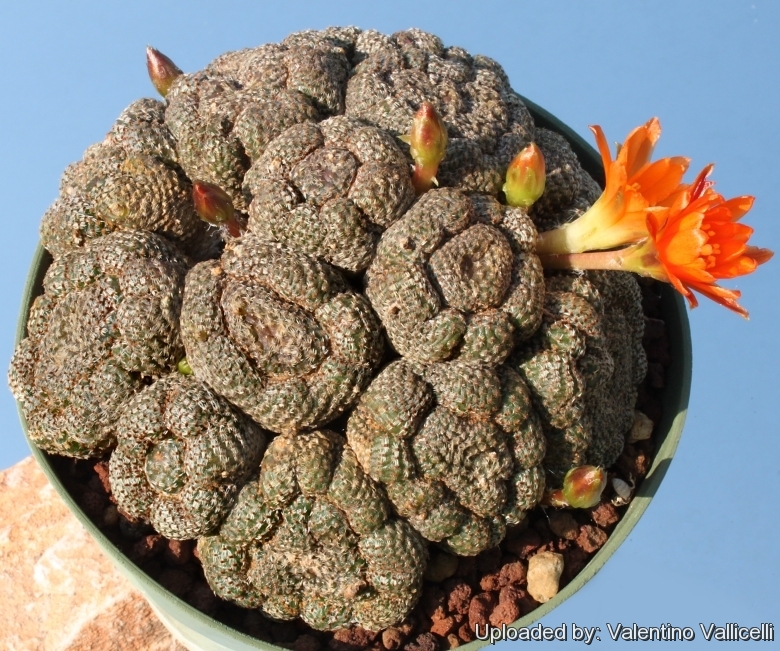
Rebutia heliosa f. monstruosa Photo by: Valentino Vallicelli
Origin and Habitat: Garden origin (Nursery produced cultivar)
Synonyms:
See all synonyms of Rebutia heliosa
back
Accepted name in llifle Database:Rebutia heliosa RauschKakteen Sukk. 21: 30, figs. 1970Synonymy: 31
Cultivars
(4):
back
Description: The Rebutia heliosaSN|5204]]SN|5204]] f. monstruosa|SN|15775]] is a strange clustering cactus that forms a low growing mound of flattened stems. The apex of each branch, after an initial normal growth, go crazy and starts to produce bumped structures or even dichotomize funnily.
This odd cactus is very distinctive.
Habit:It is essentially a miniature plant simple at first, that readily forms a clustering mound of tiny heads.
Stem: Heads compressed spherical to shortly cylindrical approx 2-3 cm wide, 1-3 cm tall.
Areoles: Small, brown and narrow, elongated 1-2 mm long, less than 0,5 mm broad, forming 35-40 spirals.
Spines: Less than 20 all radials, short, about 1 mm long, distinctively silvery-white, dense, speading laterally and pectinate
Roots: Fleshy tap root.
Flower: Large, funnel-shaped, long-necked, 4 cm in diameter, 4,5-5,5 cm long, orange-red. Tube up to 3 cm long 2-3 mm across, solid for more than half its length, deep rose to orange pink. Tepals orange with lilac mid-stripe.
Phenology: It flowers in spring.
Subspecies, varieties, forms and cultivars of plants belonging to the Rebutia heliosa group
 Rebutia densipectinata KK849 f.ma brevispina hort.: This is one of the most remarkable red blooming Rebutias with short, tiny silvery brown spines and purple tinged stem reminding of Sulcorebutia rauschii.
Rebutia densipectinata KK849 f.ma brevispina hort.: This is one of the most remarkable red blooming Rebutias with short, tiny silvery brown spines and purple tinged stem reminding of Sulcorebutia rauschii. Rebutia densipectinata KK849 Jucanas, Tarija, Bolivia 2800m (3000m) Kníže non F.Ritter: (same as: R. heliosa var. condorensis and var. melanistic?) forms a mound of tiny heads covered by white to tan coloure pectinated spines. Blossoms bright red.
Rebutia densipectinata KK849 Jucanas, Tarija, Bolivia 2800m (3000m) Kníže non F.Ritter: (same as: R. heliosa var. condorensis and var. melanistic?) forms a mound of tiny heads covered by white to tan coloure pectinated spines. Blossoms bright red. Rebutia heliosa Rausch: It is a miniature plant that readily forms a clustering mound of tiny heads. The spines are very short, silvery, dense and pectinate, covering almost completely the small stems in a spiral pattern. Blooms orange.
Rebutia heliosa Rausch: It is a miniature plant that readily forms a clustering mound of tiny heads. The spines are very short, silvery, dense and pectinate, covering almost completely the small stems in a spiral pattern. Blooms orange. Rebutia heliosa var. cajasensis Donald: has orange-red or red flowers, larger heads with silvery pectinated spines. It looks pretty like v. condorensis but lighter spined. Distribution: Desfiladero de Cajas
Rebutia heliosa var. cajasensis Donald: has orange-red or red flowers, larger heads with silvery pectinated spines. It looks pretty like v. condorensis but lighter spined. Distribution: Desfiladero de Cajas Rebutia heliosa var. condorensis Donald: The variety “condorensis” specifically describes the clones of the species with dark red flowers, and larger heads. Distribution: Condor pass.
Rebutia heliosa var. condorensis Donald: The variety “condorensis” specifically describes the clones of the species with dark red flowers, and larger heads. Distribution: Condor pass. Rebutia heliosa var. condorensis f. cristata hort.: Crested form.
Rebutia heliosa var. condorensis f. cristata hort.: Crested form. Rebutia heliosa f. cristata hort.: The crested stems are 2,5-4 cm thick and eventually forms a brain-shaped clump 10 to 20 cm across.
Rebutia heliosa f. cristata hort.: The crested stems are 2,5-4 cm thick and eventually forms a brain-shaped clump 10 to 20 cm across. Rebutia heliosa f. monstruosa hort.: each branch, after an initial normal growth, go crazy and starts to produce bumped structures or even dichotomize funnily. This odd cactus is very distinctive.
Rebutia heliosa f. monstruosa hort.: each branch, after an initial normal growth, go crazy and starts to produce bumped structures or even dichotomize funnily. This odd cactus is very distinctive.- Rebutia heliosa var. solisioides hort.
 Rebutia heliosa subs. teresae Kníže, Říha & Šeda: It is a long-spined form. The spines are not quite as appressed and the areoles are not as elongated. The flowers are more intensely red-orange. Distribution: Cajas Pass, near Nogales, North West of Tarija.
Rebutia heliosa subs. teresae Kníže, Říha & Šeda: It is a long-spined form. The spines are not quite as appressed and the areoles are not as elongated. The flowers are more intensely red-orange. Distribution: Cajas Pass, near Nogales, North West of Tarija. Rebutia heliosa cv. Yellow: albinos form.
Rebutia heliosa cv. Yellow: albinos form.
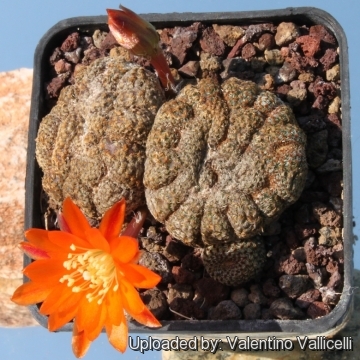 Rebutia heliosa f. monstruosa Photo by: Valentino Vallicelli
Rebutia heliosa f. monstruosa Photo by: Valentino Vallicelli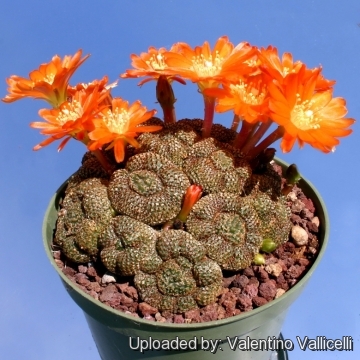 Rebutia heliosa f. monstruosa Photo by: Valentino Vallicelli
Rebutia heliosa f. monstruosa Photo by: Valentino Vallicelli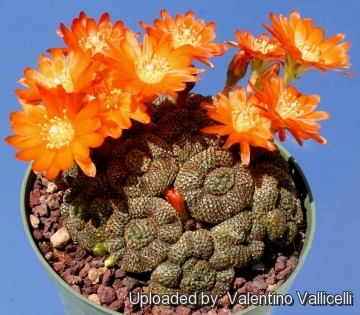 Rebutia heliosa f. monstruosa Photo by: Valentino Vallicelli
Rebutia heliosa f. monstruosa Photo by: Valentino Vallicelli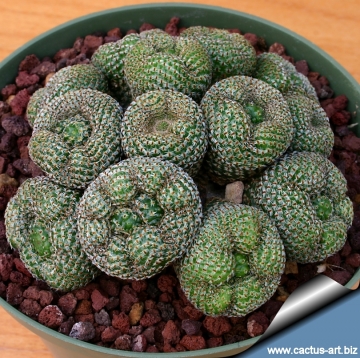 Rebutia heliosa f. monstruosa Photo by: Cactus Art
Rebutia heliosa f. monstruosa Photo by: Cactus Art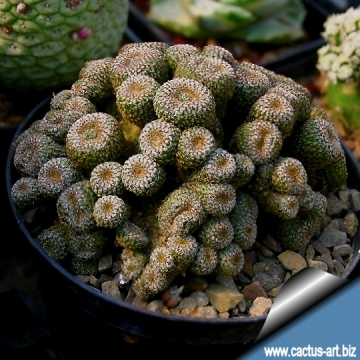 Rebutia heliosa f. monstruosa Photo by: Cactus Art
Rebutia heliosa f. monstruosa Photo by: Cactus Art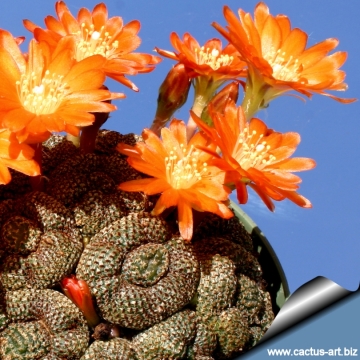 Rebutia heliosa f. monstruosa Photo by: Cactus Art
Rebutia heliosa f. monstruosa Photo by: Cactus ArtCultivation and Propagation: These plants come from mountainous areas, so like bright light, cool and dry conditions in the winter; this is important for the flowers as well as for their health. Without this cool winter period (0-10° C) they normally won't get many buds. They have a thick taproot and are of difficult cultivation and rot prone because of a great sensitivity to the excess of watering, not easy to get to any large size on their own roots really a challenge to grow into a large clump. They are commonly grafted to avoid root problems and to make easier to grow. It is very cold resistant as low as to -5° C or less for short periods of time. It is a fine plant for a rock garden or container, contrasts well with agaves, yuccas, and low-growing flowering plants.
Sun Exposure: Suited for sunny-brightly exposure; can tolerate light shade.
Cultural Practices: Suited for airy exposures. Needs deep pot and good drainage to accommodate its tap root.
Pests & diseases: It is especially prone to root rot, therefore, underpot in a smaller container filled with very porous compost.
Propagation: Usually grafted but the offsets can be used as cuttings which will take root in a minimum temperature of 20° C. Cuttings of healthy shoots can be taken in the spring and summer. Cut the stem with a sharp, sterile knife, leave the cutting in a warm, dry place for a week or weeks (depending on how thick the cutting is) until a callus forms over the wound. Once the callus forms, the cutting may be inserted in a container filled with firmed cactus potting mix topped with a surface layer of coarse grit. They should be placed in the coarse grit only; this prevents the cut end from becoming too wet and allows the roots to penetrate the rich compost underneath. The cuttings should root in 2 to 6 weeks. They grow slowly.

















